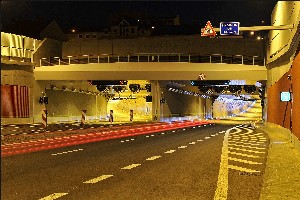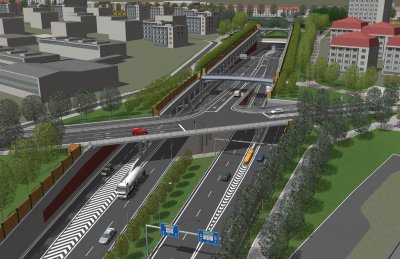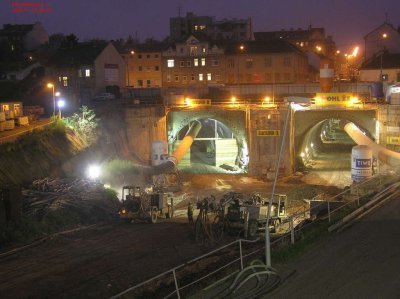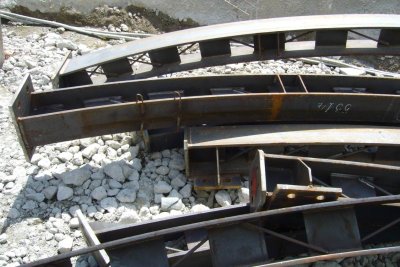Královo Pole Tunnels Brno - LCCR Dobrovského
Královo Pole Tunnels, Brno – LCCR Dobrovského
Owner:
Directorate of Roads and Motorways of the Czech Republic, the Corporate City of Brno and the State Fund of Traffic Infrastructure
Contractor:
Sdružení VMO Dobrovského B consortium (OHL ŽS, a. s. - consortium leader; Metrostav a. s.; Subterra a. s.)
Consulting Engineer:
Engineering consortium consisting of AMBERG Engineering Brno, a. s., PK OSSENDORF, s. r. o., DOSING – Dopravoprojekt Brno group, s. r. o.
GTM services:
GEOtest Brno, a. s., SG – Geotechnika a. s.
Construction period:
2006 - 2012
Engineering data:
In February 2008, Brno saw the commencement of the excavation of the Královo Pole tunnels, which are part of the route of the Large City Circle Road, the I/42 road in the Žabovřeská – Dobrovského Street section. Two parallel, double-lane, about 1250m long mined tunnels (Královo Pole) are the main element of the entire project. The Tunnel I leads along the Žabovřeská-Dobrovského line, whilst the tunnel II runs in parallel, about 60m south, on the extended axis of Pešinova Street.
Tunnel I is 1237m long in total; of that length the mined part takes 1019m. Cut-and-cover sections, which are constructed in an open box, are 168m and 50m long in Žabovřesky and Královo Pole respectively.
Tunnel II is 1258m long in total; of that length the mined part takes 1060m. The cut-and-cover parts are constructed by the same technique as those for the Tunnel I; in open boxes they are 149m and 49m long in Žabovřesky and Královo pole respectively.
Tunnel cross section – basic engineering data:
Basic width of traffic lanes in the tunnel … 3.50 m;
Height clearance … 4.50 m;
Curb-to-curb width … 8.50 m;
Traffic space area … 57.95 m2;
Polluted air exhaust space … 12.0 m2;
Primary lining 350mm thick … 11.95 m3/lm;
Secondary lining min. 500mm thick … 32.53 m3/lm;
Excavated cross-sectional area … about 130 m2.
Geology
The geological sequence within the tunnel cross section is relatively monotonous – cover layers, consisting of secondary loess and anthropogenic fills, are 3 to 10m thick, with layers of locally saturated gravel to sand terraces in the bottom horizon. The layer underlying the terrace consists of Neogene clays (the so-called Brno tegel), forming layers up to several tens of meters thick (the bedrock was not encountered by boreholes over 60m deep). Ground water is bound to gravel-sand layers in the upper Neogene horizon, in the form of aquifers in local depressions. The clays are of rigid to solid consistency. Regarding plasticity, tegels are highly plastic and, on contact with water, under certain conditions, heavily swelling. The overburden height is roughly identical for both tunnels, varying from 6m to the maximum value of about 21m. In terms of the vertical position, both tunnels are located in Neogene clays, in a way guaranteeing that the minimum impermeable height of the Neogene clay overburden of about 2 to 3m above the excavation is always maintained.
The high-density surface development, together with related utility networks and roads on the surface and the difficult conditions of the Brno clay (tegel), ranks the Královo Pole tunnelling project among absolutely unique civil engineering projects, having no equal in the Czech Republic.
The construction method, excavation sequence and reinforcement of the primary shotcrete lining by means of HEBREX elements, which were developed especially for this project, were used for the first time in the Czech Republic. The monitoring of impacts of the construction (above all the tunnel excavation) was as extensive as was been carried out in the Czech Republic.
Královo Pole Tunnels have been in operation since 31.8.2012. This construction contributes to the fluent traffic in Brno.
In the end of 2012 was published a book Královopolský tunel Brno (publishing house Doplněk). Authors team headed by Vladislav Horák acquaints the readers with this building of great importance in an original way.
Visualization of portal Žabovřesky
Temporary portal
HERBEX elements

Královo pole Tunnels in operation




